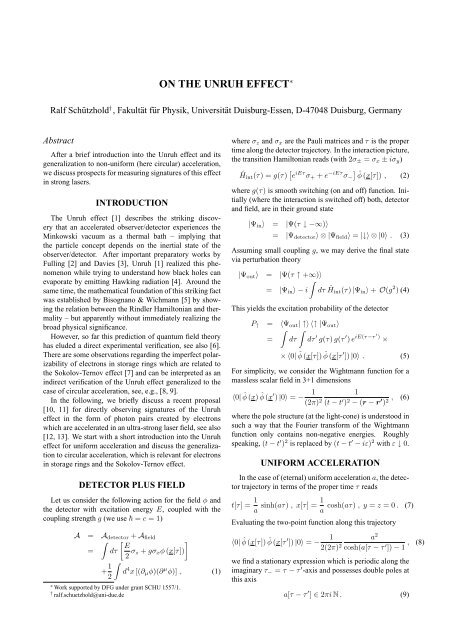Proceedings of International Conference on Physics in ... - KEK
Proceedings of International Conference on Physics in ... - KEK
Proceedings of International Conference on Physics in ... - KEK
Create successful ePaper yourself
Turn your PDF publications into a flip-book with our unique Google optimized e-Paper software.
ON THE UNRUH EFFECT ∗<br />
Ralf Schützhold † , Fakultät für Physik, Universität Duisburg-Essen, D-47048 Duisburg, Germany<br />
Abstract<br />
After a brief <strong>in</strong>troducti<strong>on</strong> <strong>in</strong>to the Unruh effect and its<br />
generalizati<strong>on</strong> to n<strong>on</strong>-uniform (here circular) accelerati<strong>on</strong>,<br />
we discuss prospects for measur<strong>in</strong>g signatures <str<strong>on</strong>g>of</str<strong>on</strong>g> this effect<br />
<strong>in</strong> str<strong>on</strong>g lasers.<br />
INTRODUCTION<br />
The Unruh effect [1] describes the strik<strong>in</strong>g discovery<br />
that an accelerated observer/detector experiences the<br />
M<strong>in</strong>kowski vacuum as a thermal bath – imply<strong>in</strong>g that<br />
the particle c<strong>on</strong>cept depends <strong>on</strong> the <strong>in</strong>ertial state <str<strong>on</strong>g>of</str<strong>on</strong>g> the<br />
observer/detector. After important preparatory works by<br />
Full<strong>in</strong>g [2] and Davies [3], Unruh [1] realized this phenomen<strong>on</strong><br />
while try<strong>in</strong>g to understand how black holes can<br />
evaporate by emitt<strong>in</strong>g Hawk<strong>in</strong>g radiati<strong>on</strong> [4]. Around the<br />
same time, the mathematical foundati<strong>on</strong> <str<strong>on</strong>g>of</str<strong>on</strong>g> this strik<strong>in</strong>g fact<br />
was established by Bisognano & Wichmann [5] by show<strong>in</strong>g<br />
the relati<strong>on</strong> between the R<strong>in</strong>dler Hamilt<strong>on</strong>ian and thermality<br />
– but apparently without immediately realiz<strong>in</strong>g the<br />
broad physical significance.<br />
However, so far this predicti<strong>on</strong> <str<strong>on</strong>g>of</str<strong>on</strong>g> quantum field theory<br />
has eluded a direct experimental verificati<strong>on</strong>, see also [6].<br />
There are some observati<strong>on</strong>s regard<strong>in</strong>g the imperfect polarizability<br />
<str<strong>on</strong>g>of</str<strong>on</strong>g> electr<strong>on</strong>s <strong>in</strong> storage r<strong>in</strong>gs which are related to<br />
the Sokolov-Ternov effect [7] and can be <strong>in</strong>terpreted as an<br />
<strong>in</strong>direct verificati<strong>on</strong> <str<strong>on</strong>g>of</str<strong>on</strong>g> the Unruh effect generalized to the<br />
case <str<strong>on</strong>g>of</str<strong>on</strong>g> circular accelerati<strong>on</strong>, see, e.g., [8, 9].<br />
In the follow<strong>in</strong>g, we briefly discuss a recent proposal<br />
[10, 11] for directly observ<strong>in</strong>g signatures <str<strong>on</strong>g>of</str<strong>on</strong>g> the Unruh<br />
effect <strong>in</strong> the form <str<strong>on</strong>g>of</str<strong>on</strong>g> phot<strong>on</strong> pairs created by electr<strong>on</strong>s<br />
which are accelerated <strong>in</strong> an ultra-str<strong>on</strong>g laser field, see also<br />
[12, 13]. We start with a short <strong>in</strong>troducti<strong>on</strong> <strong>in</strong>to the Unruh<br />
effect for uniform accelerati<strong>on</strong> and discuss the generalizati<strong>on</strong><br />
to circular accelerati<strong>on</strong>, which is relevant for electr<strong>on</strong>s<br />
<strong>in</strong> storage r<strong>in</strong>gs and the Sokolov-Ternov effect.<br />
DETECTOR PLUS FIELD<br />
Let us c<strong>on</strong>sider the follow<strong>in</strong>g acti<strong>on</strong> for the field ϕ and<br />
the detector with excitati<strong>on</strong> energy E, coupled with the<br />
coupl<strong>in</strong>g strength g (we use = c = 1)<br />
A = Adetector + Afield<br />
∫ [<br />
E<br />
= dτ<br />
2 σz<br />
]<br />
+ gσxϕ (x[τ])<br />
+ 1<br />
∫<br />
2<br />
d 4 x [(∂µϕ)(∂ µ ϕ)] , (1)<br />
∗ Work supported by DFG under grant SCHU 1557/1.<br />
† ralf.schuetzhold@uni-due.de<br />
where σz and σx are the Pauli matrices and τ is the proper<br />
time al<strong>on</strong>g the detector trajectory. In the <strong>in</strong>teracti<strong>on</strong> picture,<br />
the transiti<strong>on</strong> Hamilt<strong>on</strong>ian reads (with 2σ± = σx ± iσy)<br />
]<br />
ˆϕ (x[τ]) , (2)<br />
ˆH<strong>in</strong>t(τ) = g(τ) [ e iEτ σ+ + e −iEτ σ−<br />
where g(τ) is smooth switch<strong>in</strong>g (<strong>on</strong> and <str<strong>on</strong>g>of</str<strong>on</strong>g>f) functi<strong>on</strong>. Initially<br />
(where the <strong>in</strong>teracti<strong>on</strong> is switched <str<strong>on</strong>g>of</str<strong>on</strong>g>f) both, detector<br />
and field, are <strong>in</strong> their ground state<br />
|Ψ<strong>in</strong>⟩ = |Ψ(τ ↓ −∞)⟩<br />
= |Ψdetector⟩ ⊗ |Ψfield⟩ = |↓⟩ ⊗ |0⟩ . (3)<br />
Assum<strong>in</strong>g small coupl<strong>in</strong>g g, we may derive the f<strong>in</strong>al state<br />
via perturbati<strong>on</strong> theory<br />
|Ψout⟩ = |Ψ(τ ↑ +∞)⟩<br />
∫<br />
= |Ψ<strong>in</strong>⟩ − i<br />
dτ ˆ H<strong>in</strong>t(τ) |Ψ<strong>in</strong>⟩ + O(g 2 ) .(4)<br />
This yields the excitati<strong>on</strong> probability <str<strong>on</strong>g>of</str<strong>on</strong>g> the detector<br />
P↑ = ⟨Ψout| ↑⟩ ⟨↑ |Ψout⟩<br />
=<br />
∫ ∫<br />
dτ dτ ′ g(τ) g(τ ′ ) e iE(τ−τ ′ )<br />
×<br />
× ⟨0| ˆ ϕ (x[τ]) ˆ ϕ (x[τ ′ ]) |0⟩ . (5)<br />
For simplicity, we c<strong>on</strong>sider the Wightmann functi<strong>on</strong> for a<br />
massless scalar field <strong>in</strong> 3+1 dimensi<strong>on</strong>s<br />
⟨0| ˆ ϕ (x) ˆ ϕ (x ′ ) |0⟩ = − 1<br />
(2π) 2<br />
1<br />
(t − t ′ ) 2 − (r − r ′ , (6)<br />
) 2<br />
where the pole structure (at the light-c<strong>on</strong>e) is understood <strong>in</strong><br />
such a way that the Fourier transform <str<strong>on</strong>g>of</str<strong>on</strong>g> the Wightmann<br />
functi<strong>on</strong> <strong>on</strong>ly c<strong>on</strong>ta<strong>in</strong>s n<strong>on</strong>-negative energies. Roughly<br />
speak<strong>in</strong>g, (t − t ′ ) 2 is replaced by (t − t ′ − iε) 2 with ε ↓ 0.<br />
UNIFORM ACCELERATION<br />
In the case <str<strong>on</strong>g>of</str<strong>on</strong>g> (eternal) uniform accelerati<strong>on</strong> a, the detector<br />
trajectory <strong>in</strong> terms <str<strong>on</strong>g>of</str<strong>on</strong>g> the proper time τ reads<br />
t[τ] = 1<br />
a<br />
s<strong>in</strong>h(aτ) , x[τ] = 1<br />
a<br />
cosh(aτ) , y = z = 0 . (7)<br />
Evaluat<strong>in</strong>g the two-po<strong>in</strong>t functi<strong>on</strong> al<strong>on</strong>g this trajectory<br />
⟨0| ˆ ϕ (x[τ]) ˆ ϕ (x[τ ′ ]) |0⟩ = − 1<br />
2(2π) 2<br />
a2 cosh(a[τ − τ ′ , (8)<br />
]) − 1<br />
we f<strong>in</strong>d a stati<strong>on</strong>ary expressi<strong>on</strong> which is periodic al<strong>on</strong>g the<br />
imag<strong>in</strong>ary τ− = τ − τ ′ -axis and possesses double poles at<br />
this axis<br />
a[τ − τ ′ ] ∈ 2πi N . (9)













